Invisible fossils of the first animals
Though the first animals on Earth didn’t leave behind rock fossils, scientists can still find these ancient creatures by observing their invisible molecular fossils
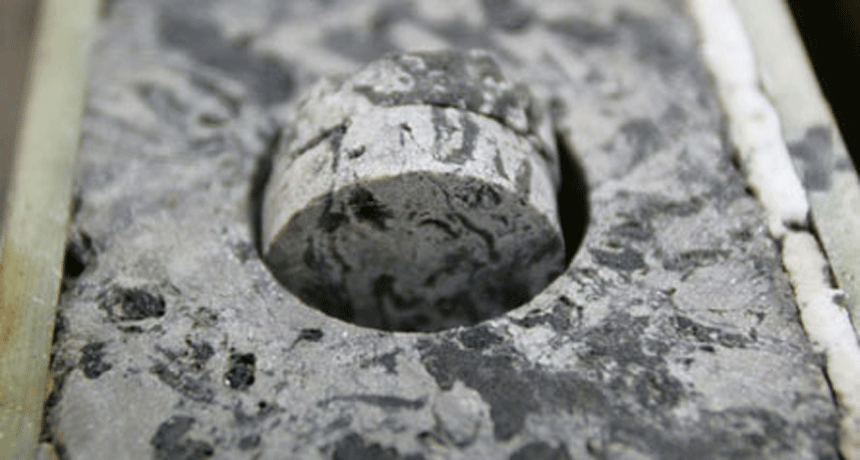
This stone core was drilled from an ancient seabed that now lies nearly 3 miles underground. The dark color comes from oil left behind by bacteria and animals that lived over 500 million years ago. The white color comes from salt left behind by the sea.
Petroleum Development Oman
By Douglas Fox
Gordon Love walked past the warm waters of the Arabian Sea as they lapped on a white sandy beach in the country of Oman. He entered a metal warehouse and walked past row after row of hallways lined with sliding metal doors. Some of these doors concealed an important piece of history.
Love, a geochemist now at the University of California, Riverside, had come to the Middle East to work for an oil company for a couple of weeks. But this trip would also give him a rare chance to look at rocks from deep inside the Earth. It would lead him and his partners to a major new discovery about early life on our planet.
Behind each one of the warehouse’s metal doors lay a cylinder of stone about the width and length of a baseball bat. You might call this warehouse a library of both rocks and history. These cylinders of stone — called cores — were drilled from the flat and dusty deserts of Oman by people looking for oil. The stone cores were lifted out of drill holes that reach three miles underground. Those drill holes pierced through layer after layer of petrified mud, which contained once-living material that turned into rock over time. This mud collected over millions of years on an ancient sea bed. You can see the layers as stripes of gray, white and brown stone in the cores. If you stacked these cores end to end they would run for miles — and they would tell the history of this ancient sea now buried beneath the desert.
Love entered a room where dozens of sections of core were laid out on tables. He could tell from the brown color of the stone that it still contained tiny bits of oil. That brown stone was just what he was looking for.
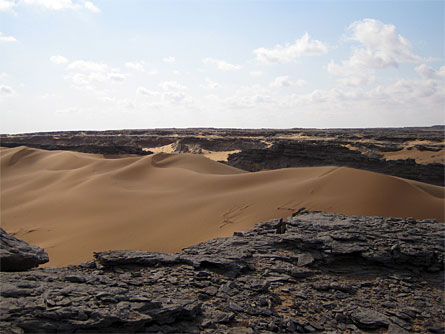 |
|
Scientist Gordon Love looked at molecular fossils in rocks as deep as 3 miles underground, similar to the dark ones shown here in the desert of Oman.
|
| David Fike, Washington University |
Molecular fossils
Oil doesn’t just fuel cars, trucks and airplanes. It also contains a record of the past. Oil contains chemical traces of things that lived hundreds of millions of years ago. Scientists call these chemicals “molecular fossils.” They can exist even when more obvious fossils, like the imprints of leaves or seashells pressed into rocks, do not survive the extreme heat and pressure of being buried deep in the Earth.
By studying the molecular fossils in the cores lifted from drill holes, Love and his colleague, Roger Summons of the Massachusetts Institute of Technology (MIT), have found evidence of animals that lived as long as 751 million years ago.
“At present it’s the oldest fossil evidence for animals,” says Love. In fact, it’s up to 176 million years older than any other animal fossils that scientists have found.
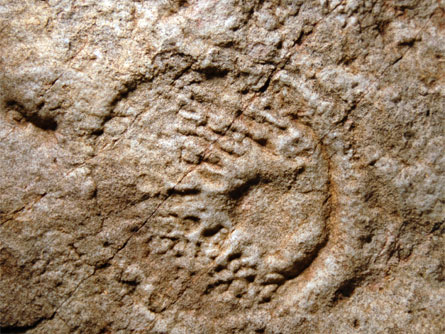 |
|
This 550 million-year-old fossil from Australia may be the oldest fossil imprint of a sponge.
|
| James Gehling, South Australia Museum in Adelaide |
The animals that Love found may have been some of the first on Earth. Human eyes have never seen these animals and have never even seen the faint shapes that they left pressed between rocks. The tortures of the deep Earth have long since erased those shapes. But by studying the invisible molecular fossils left behind by these animals, Love and Summons can not only tell that these creatures lived — they can actually make some guesses about what they looked like.
Greasy black tar
Oil forms over millions of years as dead plants, animals and bacteria are buried beneath sand or mud and decompose deep underground. Most of the grease seeps out of rocks and drains into spaces underground where it collects in large pools — the places where oil companies like to aim their drills. This oil in Oman is the oldest oil that companies have ever tried to drill out of the ground and turn into gasoline. This oil came from bacteria, algae and other critters that lived in an ocean over 500 million years ago.
The kind of molecular fossil left behind depends on the kind of organism decomposing. Bacterial molecular fossils look different from those fossils left behind by animals, for example. By studying such fossils, Summons and Love hoped to find out what kinds of things were living in the ocean when the rocks formed.
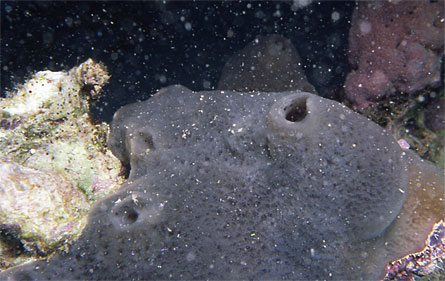 |
|
This adult sponge, about the size of a fist, was found in ankle-deep water in the Great Barrier Reef off Australia’s coast.
|
| Sally Leys, University of Alberta, Edmonton) |
In the warehouse that day, Love sawed some marble-sized chunks of rock out of the cores. The rock was as hard as cement. He took his little pieces of rock back to Summons’ lab in Cambridge, and crushed them into dust. He cooked the dust in acid until he was left with a glob of greasy black tar — the remains of ancient dead things.
Love spent another two weeks purifying, or removing unwanted material from, this tar until he held in his hand a test tube of colorless liquid. That liquid contained the molecular fossils that he and Summons wanted to analyze. The molecular fossils were invisible to the eye. A person might not even taste the small amounts of them in the tube. But Love could detect the fossils using a refrigerator-sized machine called a GC-MS, or gas chromatograph mass spectrometer.
Love loaded a few drops of the liquid into the GC-MS and watched the computer screen as the machine analyzed the dozens of chemicals.
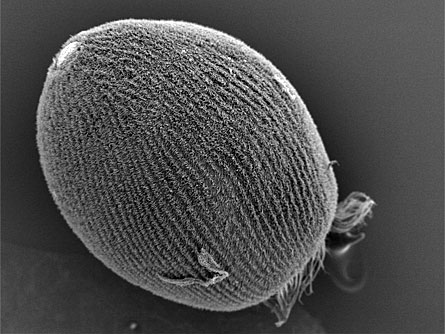 |
|
Shown is the larva, or young, of the same species of sponge pictured as an adult. About the size of a grain of salt, this tiny creature was seen through an electron microscope.
|
| Sally Leys, University of Alberta, Edmonton) |
Blobby sponges
If you’ve ever been in a hospital or seen a hospital show on TV, then maybe you’ve seen the bright line that moves across a heart monitor, tracing out jagged peaks and dips every time a person’s heart beats. Love saw something like this as he watched the GC-MS analyze the molecular fossils. A line running across the computer screen traced out a sharp spike every time the machine detected another chemical.
As Love sat and watched, one of those spikes grabbed his attention: It stood for a chemical called 24-isopropylcholestane, or 24-ipc. Love had seen 24-ipc in rocks before — it’s a well-known chemical — but seeing it in these old rocks from Oman was a big deal.
Scientists consider 24-ipc to be a molecular fossil that comes from animals called sea sponges. Scientists have looked at various animals, fungi and bacteria that live on Earth today to see which chemicals they produce. Researchers have found that sponges produce large amounts of a chemical closely related to 24-ipc. During heating, such as that deep inside the Earth, this chemical slowly changes into 24-ipc. “Sponges are the only organisms that produce it in any significant quantities,” says Love.
Sea sponges are cigar- or balloon-shaped animals that sit on the seafloor. They eat by filtering bacteria and other tiny organisms out of the water. You wouldn’t exactly call sea sponges smart. They have no brains, no eyes, no legs and no fins. They’re some of the simplest animals on Earth. Some biologists think sponges were the first animals to evolve, or develop from simpler, single-celled organisms through a process of gradual change over millions of years. So when Love saw 24-ipc in the oil from these old rocks, he knew it was important.
The oldest known sea sponge fossils that you can see with the naked eye are cup-shaped imprints found in 550-million-year-old rocks. Scientists have also seen blobby imprints, like round, quilted pillows, in rocks as old as 575 million years. (Though some scientists believe that many of these older animal fossils aren’t related to modern animals.) Researchers think these imprints were probably made by some kind of animal — although the blobs are so strange, they don’t know what kind of animal. But the molecular sponge fossils that Love had just found were much older than any of those shapes in the rocks. Judging from the age of the rocks from Oman he tested, these sea sponges are at least 635 million years old, and maybe as much as 751 million years old.
A big disagreement
These findings by Love, Summons, David Fike of Washington University in St. Louis, and nine other scientists will be published on February 5 in a major scientific journal called Nature. Their discovery has a lot of people excited. These new molecular fossils may help to solve a big disagreement about the earliest animals on Earth.
In other studies, biologists have compared the DNA, a molecule that holds an organism’s genetic information, of different animals alive today, such as sponges, clams, insects, worms, mice and humans. Scientists have done this in order to estimate how long ago the first animals lived. These “molecular clock” calculations say that the first animals evolved somewhere between 650 and 950 million years ago. And yet the oldest fossil imprints of animals are only 575 million years old.
That disagreement between the dates from the fossil imprints and the dates from the molecular clocks caused some scientists to wonder whether the molecular clock calculations were wrong. But by showing molecular fossils of animals maybe as old as 751 million years, Summons and Love’s new findings have something to say about that disagreement. “I think this new work is both important and believable,” says Andrew Knoll, a paleontologist who studies early fossils at Harvard University. “This goes a long way toward reconciling the geologic record with molecular clock estimates.”
Swimming in the early oceans
It makes sense that the first animals might have been sponges or something like them. All animals, whether they live in water or on land, need to breathe oxygen; without it, they suffocate. But 600 or 700 million years ago the Earth hadn’t yet filled up with oxygen the way it has today. The oceans probably contained oxygen in their shallowest parts, but the deeper waters likely contained hardly any oxygen.
This is one reason why it makes sense that sponges are the first animals, says Kevin Peterson of Dartmouth College in Hanover, N.H. “Sponges have exceedingly low metabolism,” he says, meaning that some kinds of sponges consume oxygen slowly compared to other animals, and so such sponges can tolerate lower levels of oxygen.
Even if these ancient animals were closely related to modern-day sponges, Knoll isn’t willing to say whether these early animals actually looked like the same big cigar-shaped sponges that we see in our oceans today.
It’s true that adult sponges are big balloons which sit on the sea floor and suck food out of the water. But young sponges, called larvae, look very different. They are tiny — about the size of a grain of sand. And rather than sitting on the ocean bottom, they swim through the water by whipping around tiny oars on their body that look like hairs.
The animals that Love detected could have looked more like tiny larvae than big adult sponges. “If you had been swimming in the same ocean, you might not have noticed them,” says Knoll.
Going Deeper:







